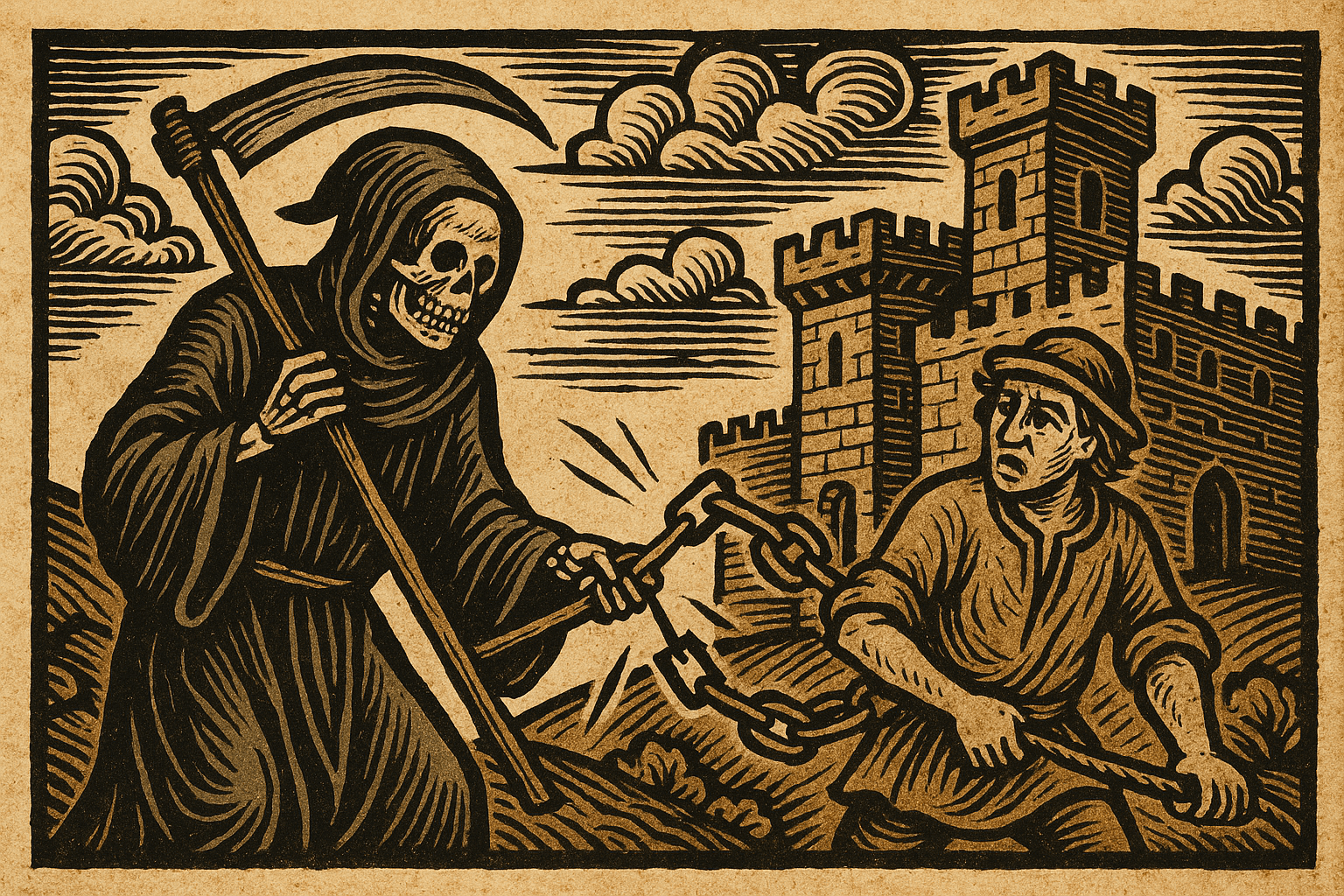The World Before the Plague: A Rigid Pyramid
To understand how the plague changed everything, we must first understand the world it struck. Mid-14th century Europe was overwhelmingly structured by the feudal system. This rigid social and economic hierarchy can be visualized as a pyramid:
- At the top was the king, who theoretically owned all the land.
- Below him were the powerful nobles and lords, who were granted large estates (fiefs or manors) in exchange for military service and loyalty.
- At the vast, sprawling base of the pyramid were the peasants, the overwhelming majority of the population.
Most peasants were serfs, a status far from freedom. A serf was bound to the land of their lord. They were not property to be bought and sold like a slave, but they could not leave the manor, marry, or even grind their own grain without the lord’s permission. In exchange for a small plot of land to farm for their own sustenance, they owed the lord labor service (known as corvée), working his fields for free several days a week. The entire system was built on one crucial economic reality: a surplus of labor. There were always more peasants than available land, which gave lords immense power. Peasants were replaceable, and they had nowhere else to go.
The Great Mortality and the Labor Shortage
The Black Death didn’t care about social status. It killed kings and commoners, priests and farmers alike. When the dust began to settle in the early 1350s, survivors looked around at a hauntingly empty world. Entire villages had vanished. Monasteries were decimated. And, most importantly for the economy, fields lay fallow because there was no one left to work them.
The economic tables had been violently turned. The pre-plague surplus of labor had evaporated and been replaced by a severe, desperate labor shortage. For the first time in centuries, the surviving peasants found themselves in a position of power. A lord with a thousand acres of land was no longer rich if he couldn’t find anyone to plow the fields, sow the seeds, and harvest the crops. Labor, not land, suddenly became the most valuable commodity.
Surviving peasants quickly realized their new worth. They began to demand what was previously unthinkable:
- Higher Wages: Free laborers—peasants not tied to a specific manor—could command wages that doubled or even tripled from pre-plague levels.
- Better Conditions: Serfs began negotiating with their lords, demanding an end to the most arduous labor services.
- Mobility: The most revolutionary change was peasant mobility. A serf could now abandon his ancestral manor, knowing that a neighboring lord, desperate for workers, would welcome him with open arms and a better offer. This directly attacked the central pillar of serfdom: being tied to the land.
The Lords Push Back, The Peasants Resist
The ruling class did not take this shift lying down. The aristocracy and the crown saw their wealth and power—built on cheap, immobile labor—evaporating before their eyes. Their response was to try and legislate the world back to the way it was.
In England, King Edward III enacted the Statute of Labourers in 1351. This law attempted to freeze wages at pre-plague levels, criminalize peasants who refused to work for those wages, and punish lords who offered more. Similar laws were passed across Europe. But these measures were a spectacular failure. The economic reality of supply and demand was far more powerful than any royal decree. Lords themselves quietly broke the law, poaching workers from their neighbors with better offers. The genie of peasant leverage could not be put back in the bottle.
The old deference was gone. Peasants no longer saw their lot in life as divinely ordained and unchangeable. They had seen the fragility of the noble class and had tasted the power of their own labor.
This new sense of worth and rising expectations often boiled over into open conflict. When lords and kings tried to claw back their old privileges or raise taxes to fund wars, the peasantry erupted. The most famous of these uprisings was the English Peasants’ Revolt of 1381. Sparked by a hated poll tax, tens of thousands of peasants marched on London, demanding the end of serfdom and the removal of corrupt officials. While the revolt was brutally crushed and its leaders executed, its message was clear: the old social contract was broken.
The Slow Collapse of the Feudal Order
The Black Death did not end feudalism overnight, but it dealt a fatal blow from which the system in Western Europe would never recover. Over the next century, the long-term consequences cemented a new social order.
Many lords, unable to force labor service, gave up trying. Instead, they began leasing their lands to peasants for fixed cash rents. This practice, known as commutation, transformed serfs into more independent tenant farmers. This shift accelerated the move away from a barter-and-service economy towards a more modern, cash-based economy.
As the power of the land-based aristocracy waned, the power of kings and centralized states grew. Monarchs could now tax the increasingly cash-rich towns and farmers directly, allowing them to fund professional armies rather than relying on their feudal vassals.
The Black Death was a profound human tragedy, but it was also a historical watershed. By creating an unprecedented labor crisis, it empowered the lowest rungs of society, eroded the economic power of the feudal lords, and cleared the way for the end of serfdom. It demonstrated that even the most entrenched social structures could be fractured by sudden and dramatic change. The world that emerged from the shadow of the plague was one where the common person had a newfound sense of value and agency, planting the seeds for the economic and social revolutions of the centuries to come.
